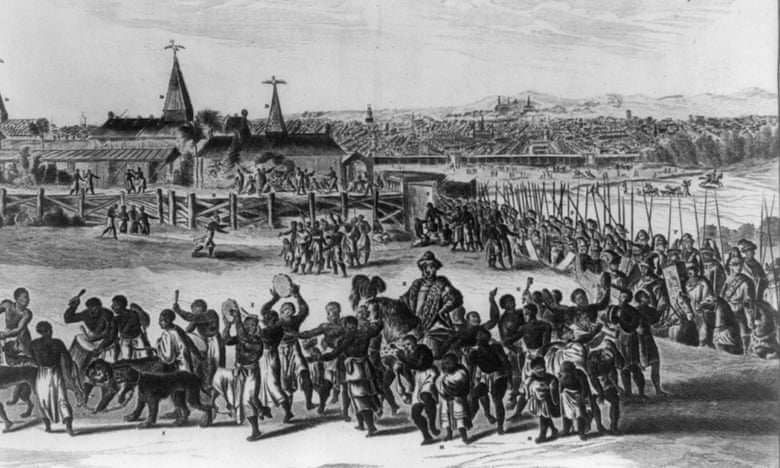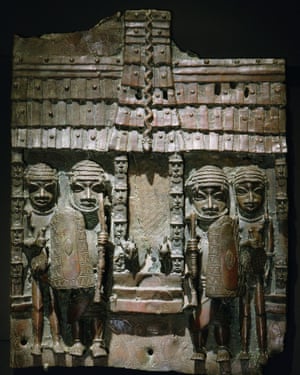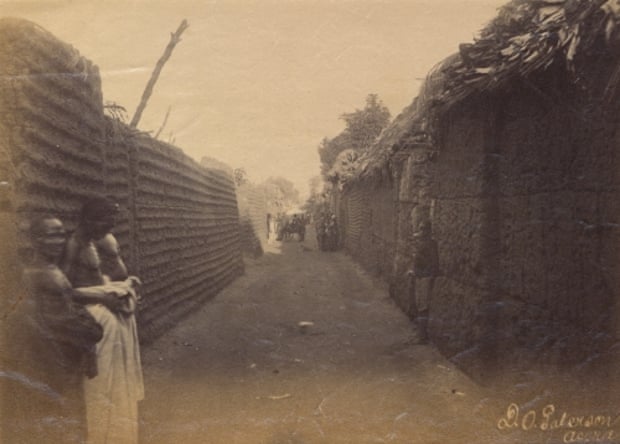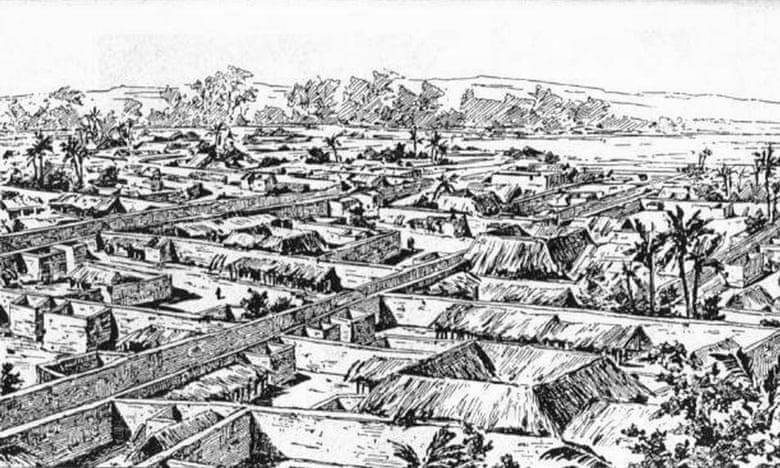With its mathematical layout and earthworks longer than the Great Wall of China, Benin City was one of the best planned cities in the world when London was a place of ‘thievery and murder’. So why is nothing left?
 |
| Benin City was described as ‘wealthy and industrious, well-governed and richly decorated’. Illustration: Decompiling Dapper: A Preliminary Search for Evidence |
The Guinness Book of Records (1974 edition) described the walls of Benin City and its surrounding kingdom as the world’s largest earthworks carried out prior to the mechanical era. According to estimates by the New Scientist’s Fred Pearce, Benin City’s walls were at one point “four times longer than the Great Wall of China, and consumed a hundred times more material than the Great Pyramid of Cheops”.
Situated on a plain, Benin City was enclosed by massive walls in the south and deep ditches in the north. Beyond the city walls, numerous further walls were erected that separated the surroundings of the capital into around 500 distinct villages.
Pearce writes that these walls “extended for some 16,000 km in all, in a mosaic of more than 500 interconnected settlement boundaries. They covered 6,500 sq km and were all dug by the Edo people … They took an estimated 150 million hours of digging to construct, and are perhaps the largest single archaeological phenomenon on the planet”.
Barely any trace of these walls exist today.
Benin City was also one of the first cities to have a semblance of street lighting. Huge metal lamps, many feet high, were built and placed around the city, especially near the king’s palace. Fuelled by palm oil, their burning wicks were lit at night to provide illumination for traffic to and from the palace.
When the Portuguese first “discovered” the city in 1485, they were stunned to find this vast kingdom made of hundreds of interlocked cities and villages in the middle of the African jungle. They called it the “Great City of Benin”, at a time when there were hardly any other places in Africa the Europeans acknowledged as a city. Indeed, they classified Benin City as one of the most beautiful and best planned cities in the world.
In 1691, the Portuguese ship captain Lourenco Pinto observed: “Great Benin, where the king resides, is larger than Lisbon; all the streets run straight and as far as the eye can see. The houses are large, especially that of the king, which is richly decorated and has fine columns. The city is wealthy and industrious. It is so well governed that theft is unknown and the people live in such security that they have no doors to their houses.”
In contrast, London at the same time is described by Bruce Holsinger, professor of English at the University of Virginia, as being a city of “thievery, prostitution, murder, bribery and a thriving black market made the medieval city ripe for exploitation by those with a skill for the quick blade or picking a pocket”.
African fractals
Benin City’s planning and design was done according to careful rules of symmetry, proportionality and repetition now known as fractal design. The mathematician Ron Eglash, author of African Fractals – which examines the patterns underpinning architecture, art and design in many parts of Africa – notes that the city and its surrounding villages were purposely laid out to form perfect fractals, with similar shapes repeated in the rooms of each house, and the house itself, and the clusters of houses in the village in mathematically predictable patterns.As he puts it: “When Europeans first came to Africa, they considered the architecture very disorganised and thus primitive. It never occurred to them that the Africans might have been using a form of mathematics that they hadn’t even discovered yet.”At the centre of the city stood the king’s court, from which extended 30 very straight, broad streets, each about 120-ft wide. These main streets, which ran at right angles to each other, had underground drainage made of a sunken impluvium with an outlet to carry away storm water. Many narrower side and intersecting streets extended off them. In the middle of the streets were turf on which animals fed.
 “Houses are built alongside the streets in good order, the one close to the other,” writes the 17th-century Dutch visitor Olfert Dapper.
“Adorned with gables and steps … they are usually broad with long
galleries inside, especially so in the case of the houses of the
nobility, and divided into many rooms which are separated by walls made
of red clay, very well erected.”
“Houses are built alongside the streets in good order, the one close to the other,” writes the 17th-century Dutch visitor Olfert Dapper.
“Adorned with gables and steps … they are usually broad with long
galleries inside, especially so in the case of the houses of the
nobility, and divided into many rooms which are separated by walls made
of red clay, very well erected.”Dapper adds that wealthy residents kept these walls “as shiny and smooth by washing and rubbing as any wall in Holland can be made with chalk, and they are like mirrors. The upper storeys are made of the same sort of clay. Moreover, every house is provided with a well for the supply of fresh water”.
Family houses were divided into three sections: the central part was the husband’s quarters, looking towards the road; to the left the wives’ quarters (oderie), and to the right the young men’s quarters (yekogbe).
Daily street life in Benin City might have consisted of large crowds going though even larger streets, with people colourfully dressed – some in white, others in yellow, blue or green – and the city captains acting as judges to resolve lawsuits, moderating debates in the numerous galleries, and arbitrating petty conflicts in the markets.
The early foreign explorers’ descriptions of Benin City portrayed it as a place free of crime and hunger, with large streets and houses kept clean; a city filled with courteous, honest people, and run by a centralised and highly sophisticated bureaucracy.
The city was split into 11 divisions, each a smaller replication of the king’s court, comprising a sprawling series of compounds containing accommodation, workshops and public buildings – interconnected by innumerable doors and passageways, all richly decorated with the art that made Benin famous. The city was literally covered in it.
The exterior walls of the courts and compounds were decorated with horizontal ridge designs (agben) and clay carvings portraying animals, warriors and other symbols of power – the carvings would create contrasting patterns in the strong sunlight. Natural objects (pebbles or pieces of mica) were also pressed into the wet clay, while in the palaces, pillars were covered with bronze plaques illustrating the victories and deeds of former kings and nobles.
At the height of its greatness in the 12th century – well before the start of the European Renaissance – the kings and nobles of Benin City patronised craftsmen and lavished them with gifts and wealth, in return for their depiction of the kings’ and dignitaries’ great exploits in intricate bronze sculptures.
“These works from Benin are equal to the very finest examples of European casting technique,” wrote Professor Felix von Luschan, formerly of the Berlin Ethnological Museum. “Benvenuto Celini could not have cast them better, nor could anyone else before or after him. Technically, these bronzes represent the very highest possible achievement.”
What impressed the first visiting Europeans most was the wealth, artistic beauty and magnificence of the city. Immediately European nations saw the opportunity to develop trade with the wealthy kingdom, importing ivory, palm oil and pepper – and exporting guns. At the beginning of the 16th century, word quickly spread around Europe about the beautiful African city, and new visitors flocked in from all parts of Europe, with ever glowing testimonies, recorded in numerous voyage notes and illustrations.
Lost world
Now, however, the great Benin City is lost to history. Its decline began in the 15th century, sparked by internal conflicts linked to the increasing European intrusion and slavery trade at the borders of the Benin empire.Then in 1897, the city was destroyed by British soldiers – looted, blown up and burnt to the ground. My great grandparents were among the many who fled following the sacking of the city; they were members of the elite corps of the king’s doctors.
Nowadays, while a modern Benin City has risen on the same plain, the ruins of its former, grander namesake are not mentioned in any tourist guidebook to the area. They have not been preserved, nor has a miniature city or touristic replica been made to keep alive the memory of this great ancient city.
A house composed of a courtyard in Obasagbon, known as Chief Enogie Aikoriogie’s house – probably built in the second half of the 19th century – is considered the only vestige that survives from Benin City. The house possesses features that match the horizontally fluted walls, pillars, central impluvium and carved decorations observed in the architecture of ancient Benin.
Curious tourists visiting Edo state in Nigeria are often shown places that might once have been part of the ancient city – but its walls and moats are nowhere to be seen. Perhaps a section of the great city wall, one of the world’s largest man-made monuments, now lies bruised and battered, neglected and forgotten in the Nigerian bush.
A discontented Nigerian puts it this way: “Imagine if this monument was in England, USA, Germany, Canada or India? It would be the most visited place on earth, and a tourist mecca for millions of the world’s people. A money-spinner worth countless billions in annual tourist revenue.”
Instead, if you wish to get a glimpse into the glorious past of the ancient Benin kingdom – and a better understanding of this groundbreaking city – you are better off visiting the Benin Bronze Sculptures section of the British Museum in central London.
On Sunday, an article, title: Empire Fall, detailing the fall of ancient Benin kingdom would be published on Myafropedia.com blog.
Source: Theguardian.com































